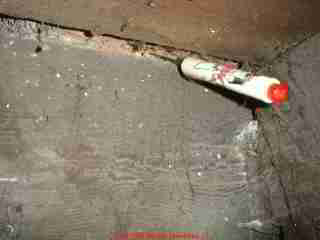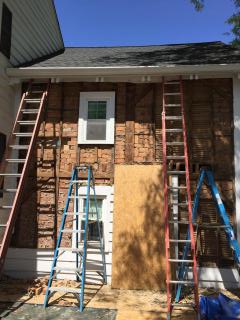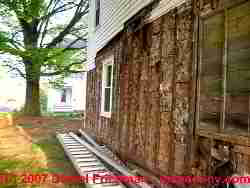 Brick Lined Walls in Wood Framed Homes
Brick Lined Walls in Wood Framed Homes
How to Detect Brick Wall Liner, What to do About "Brick Insulation" in Building Walls
- POST a QUESTION or COMMENT about the properties, identification, & repair of brick nogging or brick-lined building walls.
Brick filled cavity walls in wood frame buildings:
This article describes brick wall lining or "insulation" in buildings, why it was used, what problems may occur, and the inspection methods and clues to detect brick lined walls in older homes (sometimes called Brick Nogging) and discusses the implications of brick wall liners in buildings.
What are the insulating properties of brick used in wall cavities? Why were bricks used to line the interior of some wood-framed buildings?
How to identify the presence of brick wall lining materials and how to inspect this system for defects. How to repair brick-lined walls. What to do if part of your brick lined wall has fallen into the attic.
Non-structural bricks were used to line the exterior walls in some pre-1900 wood frame buildings primarily an air infiltration or wind barrier, possibly as "insulation" or for thermal mass, and possibly as a "sound proofing" method.
InspectAPedia tolerates no conflicts of interest. We have no relationship with advertisers, products, or services discussed at this website.
- Daniel Friedman, Publisher/Editor/Author - See WHO ARE WE?
Brick Wall Lining in Older Homes: how to identify brick nogging
Brick wall "insulation" or brick nogging may be found in wood framed buildings built up to about 1900.
Usually these homes have exterior clapboards and interior plaster walls.
Often these brick-lined wood-framed homes were built with balloon stud framing, no exterior sheathing (they used diagonal bracing), and exterior clapboards right on the studs. In homes framed in this manner, if the exterior wall cavities were left empty, the walls were drafty and uninsulated.
Some homes, such as the Weisman home in Montgomery NY (shown above) and another home photographed by Arlene Puentes (shown below), were built with brick-lined walls, bricks being mortared in between the studs on all floors and even extending into the attic.
Other benefits of this design included fire stopping effects and added thermal mass to the building, making temperature changes less rapid and thus the house more comfortable.
The presence of brick in wood frame wall cavities, such as in the photograph shown at the top of this page (Courtesy Joe and Beth Weisman) may help determine the age of a building.
The condition of the brick "nogging" may also be an important indicator of the building leak history.
Also see BRICK VENEER WALL AIR LEAKS for a discussion of modern insulation methods for brick veneer walls.
An owner of such a home usually finds out about the brick in the home walls at the first renovation or wiring or plumbing project. But a home inspector and home buyer might also be able to detect brick-lined walls and should be interested in what this construction method might mean to the new owner.
These bricks are not structural, and they were simply mortared in place between wood framed wall studs and rested on the sill plates of each floor. It would be unusual to find brick wall linings in interior walls unless at one time the "interior" wall was at one time a building exterior wall structure.
Brick Nogging was generally not intended to be exposed to view, and served the purpose of blocking wind that blew through older homes constructed without an exterior sheathing - clapboards were nailed directly to the structural frame.
Typical wall construction was stud framing, 16" o.c., diagonal wood bracing in walls, clapboard exterior, rough masonry wall filler on all floors and extending into the attic. Interior walls were covered by plaster on wood lath.
Opening walls filled with brick nogging or other masonry will often reveal rough and varying styles of masonry (as it was not intended to be seen) that went in fast.
The masons may have used a variety of bricks and rubble. I [DF] suspect that this construction method may have been adopted by builders who had observed the short life and pest infestation problems that followed colonial and later attempts at wall insulation using natural materials like straw and corncobs.
Websters Dictionary gives this definition: "Nogging: (?), n. Rough brick masonry used to fill in the interstices of a wooden frame, in building."
Wordnet Dictionary gives this similar definition: "Noun 1. nogging - rough brick masonry used to fill in the gaps in a wooden frame". "Nogging" is a term also used by some to describe exposed brick lining in timber framed walls in which the brick is left in view on the building exterior for aesthetic reasons.
Because brick (or other masonry) placed in building cavities as a wind barrier and thermal mass source was in that use not intended to be exposed, you can expect to see the workmanship quite rough in appearance and inconsistent from one building area to another (as any and various masonry material at hand might be used) compared with masonry intended to be left exposed to view.
Features of Homes with Brick Lined Walls - Brick Nogging
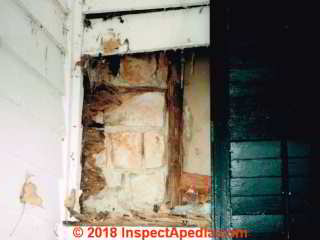 Photo: we opened this brick-lined clapboard-covered wall in a home in Poughkeepsie, New York, to show some remaining brick nogging or lining along with extensive rot of the clapboards and wall framing.
Photo: we opened this brick-lined clapboard-covered wall in a home in Poughkeepsie, New York, to show some remaining brick nogging or lining along with extensive rot of the clapboards and wall framing.
- House Age: Brick nogging helps set a possible age for the home. Houses built between 1810 and 1900, or perhaps earlier may have brick-lined walls. I [Friedman] found brick nogging lining
the walls of a 1790 house in Poughkeepsie NY.
So finding bricks in your house walls is often a clue about when it was built. - Insulating Value of Brick Wall Lining: Brick has an "R" value estimated at about 0.11", so a brick lined wall has an R-value of something like R1 overall
(including the wood siding and interior plaster) - pretty low compared with modern R11-R20 walls.
Adding conventional insulation such as fiberglass batts, blown-in fiberglass, or blown-in cellulose or foam (to save heating and cooling costs) are not an option unless walls are stripped from inside or outside first, and bricks removed.
In an extensive old house renovation, if the project includes replacing exterior siding or interior wall surfaces, and in homes where accurate historic preservation of original construction materials and details is not a requirement, it is common to remove all of the wall-lining bricks in order to substitute a more effective insulating material.
Owners who have taken this step (such as the Weismans who provided some of the photos on this page) report a significant reduction in home heating costs. - Weight of Brick-Lined Walls: Alan Carson, (Carson Dunlop Associates, Toronto) estimates that weight would be about 400 lb. per stud cavity per floor.
(Clay bricks weigh about 150 lb./cu. ft.).
If the structure is damaged by rot or insects, or modified by "remodeling" there is risk that the added weight of bricks in upper floor walls could require additional support. Beware of remodeling on lower floors which includes the removal of bricks in the wall cavities - it may be necessary to add support to be certain that weight of brick lining upper floor walls does not cause a structural problem for the lower floors. - Brick Wall Liners and Fire Safety: If the building was framed using balloon framing rather than platform framing it may be necessary to add fire blocking if bricks are removed since you may have removed what amounted to fire-blocking in the wall cavities.
- Brick Lined Wall Collapse Warning: Joe and Beth Weisman pointed out at their website [References below] that when removing exterior siding [or interior plaster] one should be careful to watch out for falling bricks. In their renovation one wall dumped
quite a few bricks on the ground [Image] when it was opened.
Puentes points out that in earthquake prone areas, "hidden" brick or other masonry wall lining could fall into an upper room and perhaps through a ceiling into a room below, making this construction method an additional safety concern for houses in earthquake zones. [We don't know if this method has been used in earthquake areas.] - Brick Walls, Condensation, and Mold: Brick wall lining may increase condensation on the interior of some exterior walls and could be a dampness or mold issue.
You may see evidence of this as mold behind pictures that have been hung on exterior walls for some time. You'll also see this in solid-masonry homes. - Electical Wiring: Running new electrical circuits in exterior walls will encounter the brick lining which may need to be removed in
some cases (or run wires behind floor baseboards or in other chases).
Carson wondered if the absence of electrical wiring (seen as no outlets nor switches) in the walls of an older building might suggest brick lining.
Where Will You Find Clues Suggesting the Presence of Brick Lined Walls
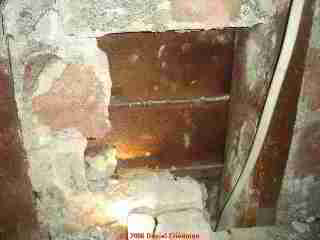 Age of the home: if the home was built before 1900 and is a wood frame structure, especially in cold climates where people care more about wind blowing through walls, brick nogging may have been used.
Age of the home: if the home was built before 1900 and is a wood frame structure, especially in cold climates where people care more about wind blowing through walls, brick nogging may have been used.
This photo shows the wall-cavity or interior surface of the exterior clapboard sheathing used on this home.
The draftiness of walls constructed in this manner was a reason that some builders used brick wall lining as
not only insulation but as "wind barrier".
I you look closely at the exposed side of the clapboards in this photograph where some wall lining bricks have conveniently fallen away, you'll see circular saw cut marks - an indicator that this house is not one of the older instances
of brick wall lining.
I estimate that this house dates from 1890.
New York State had circular saw lumber mills sooner than some other states, and saw marks are not a precise dating method, but had this been a home from 1840-1850 we may
have seen that the saw blade had left straight blade marks across the clapboard - indicating a power-operated vertical "pit saw."
Had the saw blade marks been straight but alternating in a tight "X" pattern across the clapboard
the board would have been cut on a hand-operated pit saw, and this would be a still-older home.
In the basement, bricks may be visible between floor joists sitting atop the building sills, especially in balloon-framed homes. Arlene Puentes' photograph (above) shows how subtle this clue may be as very little brick may be visible from the basement.
In the living area - bricks may be discovered in wall cavities during renovations or remodeling
Mold on Walls: while certainly not a sure bet, the presence of mold behind wall hangings occurring on exterior walls may indicate the effects of brick lined wall cavities. The brick lining can mean that the surface of this wall stays cooler longer and has more condensation on the wall surface than will be seen on the surface of interior walls.
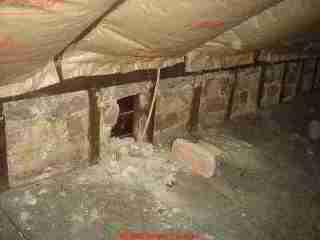 Sagging at Sills: At the interior side of exterior walls, usual degrees of sill or rim joist
crushing in areas of rot or insect damage could include the added effects of the extra weight of bricks in the building exterior walls.
Sagging at Sills: At the interior side of exterior walls, usual degrees of sill or rim joist
crushing in areas of rot or insect damage could include the added effects of the extra weight of bricks in the building exterior walls.
In the attic - (photo above / left) bricks may be visible between wall studs extending up into the attic.
In this photograph of a brick-lined
wall you can see that some of the bricks have fallen out of the wall cavity and onto the attic floor.
This is not itself a
structural problem but it may indicate a history of roof leaks at this spot. Roof leaks may in turn track to
rot or insect damage.
Based on this theory and buttressed by leak stains visible in the photograph,
I'm guessing that these fallen bricks were on an eaves wall not a gable end wall.
We discuss this further below at "Repairs".
Arlene's photograph of this brick-lined wood framed wall in an attic (below) shows the diagonal bracing commonly used in
this generation of wood frame brick-lined construction. The care with which the mason filled-in with brick and
mortar even around the diagonal bracing confirms the intention of this usage as an air barrier.
The care with which the mason filled-in with brick and
mortar even around the diagonal bracing confirms the intention of this usage as an air barrier.
Exterior Renovations: From the exterior - bricks may be visible if siding is removed for repairs or other building work
What to do if Portions of Your Brick Wall Lining Have Fallen into the Attic
- Clean up the fallen masonry and debris.
- Diagnose the reason that the bricks fell into the attic: the masonry wall filler may have been damaged
by water from roof leaks or ice dam leaks if the home is in a northern climate.
If this is the case you'll want to be sure you've corrected the cause of water leakage. If the brick collapse is traced to water leaks be sure to also look for evidence of structural rot of nearby wood framing members, and be alert for evidence of insect damage since leaks can attract carpenter ants or termites into a building, including an attic. - Consider rebuilding the brick liner in the wall cavity if you are not planning to renovate the area. Use soft mortar as was used originally. This option makes sense if only one or two bricks have fallen from place.
- Alternatively, use modern insulation - especially where lots of wall-lining bricks have fallen or are loose and appear about to fall, insulate the wall empty wall cavity with other insulating material such as fiberglass batts.
Question: How feasible would it be for me to tear down the wall from the inside, remove the brick, insulate, and then sheetrock?
2018/01/23 Peter said:
Hello!
I have an old 1830's home in Kingston NY which has brick lined walls.
One area of our home (which most likely used to be a porch) is especially drafty. It's not large... perhaps 10'x20'.
How feasible would it be for me to tear down the wall from the inside, remove the brick, insulate, and then sheetrock? Is that a crazy idea?
Reply: suggestions when replacing brick nogging with modern insulation
Peter,
It is certainly not a crazy idea to open a brick lined wall, remove bricks, add insulation, and re-sheathe the wall, working all from the inside. I have done that exact task successfully working just south of you in Poughkeepsie, NY.
This is a labor intensive approach but it has advantages of permitting an inspection of the condition of the wall structure, checks for leaks, insect damage, rot, need for orther repairs or reinforcement, addition of electrical and plumbing lines if needed.
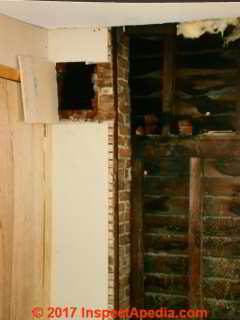 In my photo below I show not just the discovery of an improperly abandoned wood-stove flue pipe connection into a brich chimney (upper left in the photo) but also wood clapboards nailed directly to the wall studs of this 1865 home in Wappingers Falls, NY.
In my photo below I show not just the discovery of an improperly abandoned wood-stove flue pipe connection into a brich chimney (upper left in the photo) but also wood clapboards nailed directly to the wall studs of this 1865 home in Wappingers Falls, NY.
The walls of this home might have been brick-lined at some point but probably not. Someone had blown-in cellulose insulation, which I removed. Click to enlarge the image and you'll see the many water stains from rain that had entered this clapboard sheathed home's wall cavity.
Just adding insulation into the wall means having wet insulation after the next wind-driven rainstorm.
But in a gut renovation to add insulation to a brick lined wall by removing the brick there are some things to watch out for.
1. Before removing bricks in a stud bay, inspect the studs for rot or insect or other damage.
The brick infill might actually be holding up the wall if the framing is damaged. In that case you'll need to support the top plate and replace bad studs, sills, and possibly to add let-in diagonal bracing.
2. When removing the brick look at the inside surface of the exterior wall for extent of water leakage.
Often brick lined walls were in homes built with diagonal stud bracing but no exterior sheathing, just the clapboards.
The bricks may have tolerated getting wet but fiberglass or open-celled foam do not like water (risking mold and other damage). In that case I would consider closed cell foam.
3. While the wall is open that's a great time to consider adding any necessary electrical circuits, such as to add receptacles.
An alternative approach to gutting the wall cavity is to leave everything in place and to laminate solid foam insulation on the interior walls, covering that with a new layer drywall.
In my opinion that ends up being just about as much work, as you have to build out trim around windows and doors, replace window and door trim, and you give up the advantages shown above.
There are also risks of creating moisture traps in the wall structure.
Use the "Add Image" button next to the Comment button below on this page to post some photos of what you find and we may be able to offer other suggestions.
Comment: removing brick, adding foam in a brick-lined home, Newburgh NY
John said:
I am in the process of replacing the bricks in my house with insulation. There is a 1920s addition that we found to be full of bricks when we tried to have insulation added last year.
We contracted to have the siding removed so the bricks could be pulled from the outside - spray foam is scheduled this week followed by reinstallation of the original siding.
We were able to salvage the majority of the bricks as well. They were held together with plaster instead of mortar/cement and separated easily. They were a mixture of older handmade bricks and newer, formed ones.
The construction is post and beam with mortise and tenon joints (with some pegs) but was added after the house was built in 1869.
It appears that another building was moved or taken apart to be used for this addition and the bricks were installed at that point.
The attached picture is one of the three walls opened up.
This building is in the Orange Lake area of the town of Newburgh New York.
[Click to enlarge any image]
Reply: follow-up questions to consider
Thanks for the excellent photo and description of brick wall lining, John. I've seen similar homes elsewhere in the Hudson Valley including in Dutchess county.
Replacing the brick nogging with spray foam will give up thermal mass in exchange for an air-tight, highly-insulated home. Ultimately that will reduce your energy costs.
Be sure that you also run any wiring or plumbing in walls where needed before adding the insulation.
Questions:
Are you using open celled or closed-cell foam? See FOAM SPRAY INSULATION TYPES
Did you consider leaving the brick and adding solid foam sheathing on the building interior or exterior?
...
Reader Comments, Questions & Answers About The Article Above
Below you will find questions and answers previously posted on this page at its page bottom reader comment box.
Reader Q&A - also see RECOMMENDED ARTICLES & FAQs
On 2020-09-22 - by (mod) -
Breann:
Thank you for a helpful question on heat loss through brick-nogging-lined walls:
"Adequately" insulate is where the question lies, and that's open to both argument and to actually knowing something more about the building and its total heat loss or gain rate.
Leaving part of a building un-insulated except for brick nogging is leaving thermal mass, so the bricks aren't a total loss.
If there are no air leaks in the remaining brick-nogging-lined wall, then your heat loss through that wall will be less than otherwise.
If you wanted to insulate that brick-nogging wall but leave the bricks visible from indoors (a nice idea) you'd have to remove the exterior siding and add insulation on that sidce, typically as foam board; That's a lot of trouble as you're creating a discontinuity in the wall - a bump out by the thickness of the insulation, new sheathing, furring, siding, trim, etc.
Another aspect of the heat loss question is the size of the brick wall you leave exposed.
Bottom line: from just your question nobody can give a technically-sound answer based on data (yes, despite our political climate, data means a heck of a lot), but my OPINION is that it's reasonable to leave some brick exposed and in place provided you seal any cracks, gaps, openings so as not to have air leaks. And so long as that's a modest percentage of the building's wall area it is not likely to be a major energy cost.
In most buildings the heat loss is most significant from air leaks, followed by heat loss through windows, followed by losses through ceilings, attics, roofs, then walls, then floors and foundations.
Please read details at HEAT LOSS PREVENTION PRIORITIES
On 2020-09-22 by Breann
I just bought an 1895 farmhouse. The entire exterior walls are brick nogging. I have removed the plaster and am working on removing the wood lath. I plan to remove the majority of the bricks. The attic is not brick nogging. My question is whether or not is it possible to adequately insulate, but keep one of the brick walls as an accent wall in the living room. I want to maintain some of the original structure from the house as part of its history.
On 2018-10-15 by Kingston Homeowner
Hi! I just bought a house in Kingston, NY with brick nogging. If you all gleaned any interesting tidbits from your renovation projects, please let me know! I wonder if the same person built or insulated all of these structures around the Newburgh, Poughkeepsie, Kingston area.
On 2018-09-08 - by (mod) -
Thank you for the comment, I expect you're right. If you have a photo or two I'd like to see what the building looks like.
On 2018-09-08 by Christine Pete
Hi, visited an antique village in Ontario, Canada which used brick inside and wood outside. It was a shack for baking bread and I stopped in here wondering if they used the brick to insulate. Thank you for your article.. I will guess it kept the temperature in the baking shack more consistent. Cheers! C
On 2018-07-12 - by (mod) -
The thorough approach you describe would work and be perhaps first class, though it's not the only option.
Most-likely an older home without exterior sheathing will have let-in diagonal bracing at the corners. if so the sheathing was not required for structural stiffness.
The omission of any water barrier asks for trouble - worse trouble when insulation is added to wall cavities to replace the brick nogging.
An option, working from inside, might be a cleaning of the exposed wall cavities, inspection for and repair of leaks around windows and doors (from outside), and insulating with a closed-cell, therefore waterproof foam. Don't use open celled foam exposed to wind-blown water leaks into walls.
If you decide to use foam insulation be sure to run wires and pipes as needed first.
On 2018-07-11 by Rich
I have a old farm house in upstate New Jersey. I am pulling down the lath and plaster walls and am finding the nogging in the walls. There is no sheathing on the exterior, just clap board. If I take the Nogging out, should I pull the clap board off and put up sheathing and Tyvek, then put the clap board back up.
I know this is labor intensive, but I don't want a mold problem in the future. Plus I want the walls to be structurally strong too. Is there anything else I can do, am I over thinking this? I am gutting the whole farm house. Any suggestions would be a help.
...
Continue reading at THERMAL MASS in BUILDINGS or select a topic from the closely-related articles below, or see the complete ARTICLE INDEX.
Or see BRICK LINED WALLS FAQs - questions & answers posted originally at this page
Or see these
Recommended Articles
- BRICK STRUCTURAL WALLS LOOSE, BULGED
- INSULATION IDENTIFICATION GUIDE - home
- INSULATION LOCATION - WHERE TO PUT IT - home
Suggested citation for this web page
BRICK LINED WALLS at InspectApedia.com - online encyclopedia of building & environmental inspection, testing, diagnosis, repair, & problem prevention advice.
Or see this
INDEX to RELATED ARTICLES: ARTICLE INDEX to BUILDING INSULATION
Or use the SEARCH BOX found below to Ask a Question or Search InspectApedia
Ask a Question or Search InspectApedia
Try the search box just below, or if you prefer, post a question or comment in the Comments box below and we will respond promptly.
Search the InspectApedia website
Note: appearance of your Comment below may be delayed: if your comment contains an image, photograph, web link, or text that looks to the software as if it might be a web link, your posting will appear after it has been approved by a moderator. Apologies for the delay.
Only one image can be added per comment but you can post as many comments, and therefore images, as you like.
You will not receive a notification when a response to your question has been posted.
Please bookmark this page to make it easy for you to check back for our response.
IF above you see "Comment Form is loading comments..." then COMMENT BOX - countable.ca / bawkbox.com IS NOT WORKING.
In any case you are welcome to send an email directly to us at InspectApedia.com at editor@inspectApedia.com
We'll reply to you directly. Please help us help you by noting, in your email, the URL of the InspectApedia page where you wanted to comment.
Citations & References
In addition to any citations in the article above, a full list is available on request.
- Arlene Puentes, a licensed home inspector, educator, and building failures researcher in Kingston, NY. Photographs © Arlene Puentes 2006 All Rights Reserved. Text © Daniel Friedman Arlene Puentes 2007-2006 All Rights Reserved.
- Technical contributions and review: Alan Carson, Carson Dunlop Associates, Toronto, Ontario. Al Carson is a building failures researcher, educator, and a past president of ASHI, the American Society of Home Inspectors.
- Photo contributions: Joe and Beth Weisman, who have been renovating a brick-insulated house in Montgomery, NY were kind enough to share some of their website's photos for this article. Individual photo sources are cited in the text above.
- Brick nogging used as soundproofing was mentioned in a now-no-longer-online article on Popular Forest Magazine poplarforest.org
- Brick Nogging, Historical Investigation and Contemporary Repair, Construction Specifier, April 2006. Historical use of brick in timber-framed buildings, drawing on the investigations of the Kent Tavern in Calais, VT. "Brick nogging is a European method of construction which was brought to the new world in the early-nineteenth century. It was a common construction method that employed masonry as infill between the vertical uprights of wood framing." -- quoting the web article review.
- Nogging: See this photo of exposed bricks on a building exterior On a building exterior in Canada. [Thanks to Carson Dunlop, Toronto - see References below].
- Piquet Wall Construction: involving timber-framed wall construction with long top girts, diagonal timber bracing, and small diameter logs placed vertically along with concrete chinking to fill in the wall plane.
- Rubblestone Wall Filler: See this Lartigue House using exterior-exposed rubblestone filler between vertical timbers of a post and beam-framed Canadian building.
- These photos are from an 18th French fortress in Nova Scotia. See the ( Louisburg Fortress) tourist site.
- Also see the Louisburg research site.
- Our recommended books about building & mechanical systems design, inspection, problem diagnosis, and repair, and about indoor environment and IAQ testing, diagnosis, and cleanup are at the InspectAPedia Bookstore. Also see our Book Reviews - InspectAPedia.
- Brick nogging used as soundproofing was mentioned in a now-no-longer-online article on Popular Forest Magazine poplarforest.org
- Brick Nogging, Historical Investigation and Contemporary Repair, Construction Specifier, April 2006. Historical use of brick in timber-framed buildings, drawing on the investigations of the Kent Tavern in Calais, VT. "Brick nogging is a European method of construction which was brought to the new world in the early-nineteenth century. It was a common construction method that employed masonry as infill between the vertical uprights of wood framing." -- quoting the web article review.
- Nogging: See this photo of exposed bricks on a building exterior On a building exterior in Canada. [Thanks to Carson Dunlop, Toronto - see References below].
- Piquet Wall Construction: involving timber-framed wall construction with long top girts, diagonal timber bracing, and small diameter logs placed vertically along with concrete chinking to fill in the wall plane.
- Rubblestone Wall Filler: See this Lartigue House using exterior-exposed rubblestone filler between vertical timbers of a post and beam-framed Canadian building.
- In addition to citations & references found in this article, see the research citations given at the end of the related articles found at our suggested
CONTINUE READING or RECOMMENDED ARTICLES.
- Carson, Dunlop & Associates Ltd., 120 Carlton Street Suite 407, Toronto ON M5A 4K2. Tel: (416) 964-9415 1-800-268-7070 Email: info@carsondunlop.com. Alan Carson is a past president of ASHI, the American Society of Home Inspectors.
Thanks to Alan Carson and Bob Dunlop, for permission for InspectAPedia to use text excerpts from The HOME REFERENCE BOOK - the Encyclopedia of Homes and to use illustrations from The ILLUSTRATED HOME .
Carson Dunlop Associates provides extensive home inspection education and report writing material. In gratitude we provide links to tsome Carson Dunlop Associates products and services.


